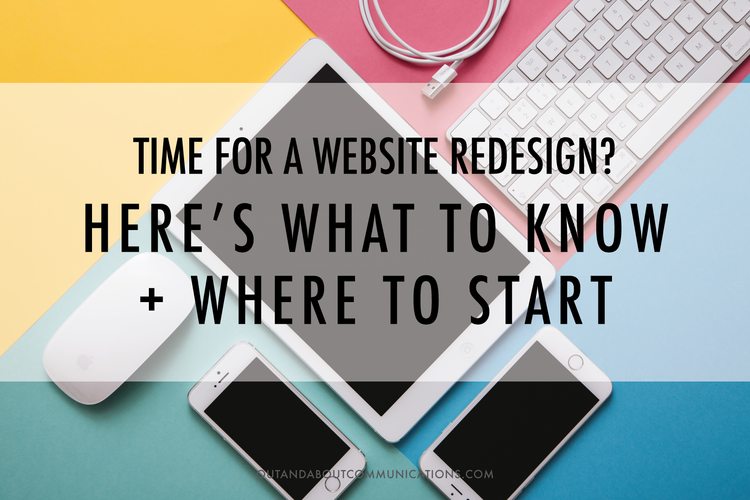
The digital world moves fast. Just as soon as you’ve mastered one social network, a new algorithm rocks it. You finally feel you have a handle on email marketing, and a new “best practice” comes along. Your team is set up using a pretty fantastic digital project management platform, and suddenly you’re hearing nonstop chatter about the new one that’s 10x better.
Where does it end? Certainly not with your website. In fact, website shame is the leading cause of business angst. (Okay, we made that up...but we believe it to be largely true.)
When it comes to your website, the constant pull to change, update, or fully redesign comes along what seems like all too often -- but sometimes, that pull is backed by sound reason.
After all, your website has an important job to do as your round-the-clock salesperson. So next time you have an inkling that your website might need a refresh, do this first: Confirm the inkling. Then, get started. Here’s how.
More than just shiny object syndrome -- how to know when it’s really time to redesign your website
In order to confirm the inkling that it’s time for a redesign, run your current website through the following filters:
1- Is it efficiently converting and capturing leads? The check: Does it have ample lead capture forms throughout the site, and are they working to convert visitors?
2- Is it continuing to serve your ideal customer? The check: Can your ideal customer land on your website and easily take the next best step that you’ve laid out for them? Has the objective changed over time, and has your website changed with it?
3- Is it modern and functional? The check: Is navigation up-to-date and intuitive? Is the site aesthetically appealing, with bells and whistles that work?
The goal here is to confirm whether your site needs a content update -- a refresh of copy, a few new pages, a clean up of what’s there, even a refresh of your branding -- or if a full redesign is needed. If there are isolated pages not working, or simple additions that need to be made, a full redesign may not be necessary.
That said, if your site truly isn’t efficiently capturing leads, is no longer serving your ideal customer, and isn’t functioning properly, then it’s time to embark upon a redesign.
Where to begin with a website redesign
“Redesign our website” is a massive to-do list item that’s sure to be procrastinated on. Cross that off right now, and break it down into smaller steps -- here are two that you’ll want to start with:
1- Your website team -- the key players in making a redesign happen, including an industry strategist, project manager, graphic designer, senior and junior web developer, SEO specialist, copywriter and others -- will be able to guide a strategic conversation, asking all the right questions to help inform the design, content, and website functionality.Internally, you’ll want to have a conversation that focuses on writing out two things: where you are now, and where you’re going. How are your business objectives changing? What do you want to be known for?In this phase, your website team might also begin wireframing pages to get a visual idea of how your redesigned site will be mapped out.
2- Complete a content audit. Once you know where you’re going, audit your content. Does it match the strategy discussed? A content audit requires taking a firm look at what exists on your site right now -- every page, subpage, and blog post. Does the voice and language match your company tone? Does it accurately reflect what you do and where you’re going in the market?Set up a Google Sheet that maps out each piece of content, its purpose, and whether it should stay or go. Consider deleting any content that doesn’t support your future goals, as it might be digital clutter that’s distracting your visitors. (Even if it’s got good SEO juice if it’s attracting the wrong people, it’s a false impression of website performance.)
Why start here? Knowing your goals -- and doing a full content audit with them in mind -- is key to developing a realistic timeframe for redesign completion, as you get a better handle on what content exists, what needs to be updated, and what needs to be newly created.
Next up: Content creation and design
You’ll notice the word content coming up quite a bit: That’s because, in nearly all circumstances, content themes drive design. A good designer won’t be able to work their magic if they don’t have at least an idea of the content they’ll be designing around.
In editing current content and creating new content, pay attention to voice: The tone and position your content takes. After all, there are more than a handful of other businesses out there offering similar products or services to yours, no doubt, but your voice and positioning is what will set you apart in your marketing.
You’ll want your content themes to be at least 90% final prior to any design or development taking place, not just so that designers understand the scope and can design around it, but also because it saves a significant amount of time (and is more cost-effective) to make copy edits, headline changes, and content tweaks prior to the development process ever beginning.
Once you nail your content themes and navigation, your website team should be able to start on at least the basic design. If needed, they can drip in dummy text where your content isn’t 100%.
This design phase is where the feeling that the copy and content inspires is amplified by the visual look. Imagine your website as a physical storefront -- how do you want your visitors to feel upon arriving? Your copy will couple with design to inspire that feeling digitally.
Critically important here (and through most of the redesign steps, as you’ll notice) is feedback. Be upfront about your likes/dislikes regarding the design -- the seemingly little things (your sidebar, choice of photos, typefaces) add up, so getting them each right is imperative.
Giving it life: The development
The design will likely take a few weeks, including the iterations based on your feedback. Once it’s in good shape, it’s time to bring your website to life online.
Your site progress will largely be out of your hands at this time as your website team builds out the design elements online, adding each piece of content and coding the unique features (forms, application customization, and more). As mentioned before, you’ll want to be available to provide critical feedback along the way.
In this phase, your website will go through several development revisions. You’ll first see the home page built out. Once the home page is finalized, work can begin on the internal pages. In Out & About’s website redesign process, we usually go through several rounds of reviews, testing, and moving elements around until it’s just right.
Some of the testing your website team will be doing as they build the bones of your site includes:
- Browser testing: Does the website function equally amongst Safari, Firefox, Chrome, and Internet Explorer?
- Responsiveness: Does the website automatically adjust to different display sizes, based on mobile, tablet, laptop, and desktop access?
- Stress testing: Can the new site handle spikes in traffic (for when that post you write goes viral), or a steady increase in visitorship over time?
Patience is key here. A tip for staying patient: While your website team is putting their skills to work, you can be behind-the-scenes generating pre-launch buzz for your newly-designed website.
Why the soft launch of a website redesign is a good idea
With pre-launch buzz generated, it’s tempting to want to shout it from the rooftops when your site is “ready” to fully launch.
Here’s our best advice, though: Start with the soft launch. A soft launch is when your website goes from a development website to your actual domain, without a lot of fanfare. For example, your website could be built on test.com and go live on mycompany.com. Hold off on announcing that launch to everyone and their mother. Instead, first announce your soft launch to a small group of trusted clients or colleagues. Have them poke around the site. Ask them to test forms. Encourage feedback.
It’s during this phase that you’re likely to notice or be made aware of, a few things that’ll need updates. Your website team should be on hand to make those immediately.
The soft launch need not last long -- a few days; maybe a week. Once things are ironed out, it’s time to make that baby known to the world.
After the redesign: ongoing website security + maintenance
The good news: Your site is live. The “less-good” news: It’s never truly complete. Websites, like cars, need constant attention and nurturing to keep functioning properly.
In some cases (like when you go through a website redesign with Out & About), your website team will be on hand to train you on how to make updates, do the complex updates that are outside of your skillset, run backups, and run security scans of your site. If this isn’t something your website team offers, you’ll want to seek it out elsewhere.
You don’t drive without insurance (right?) -- don’t let your website run without it, either.
The timeline for your website redesign
The process we’ve detailed above is incredibly simplified. When done right, a website redesign is not a cookie cutter approach, and though it will follow a very similar process, each step along the way will take more time than you likely anticipate, and nuances will spring up.
Expect your website redesign to take from a few weeks up to 4-5 months -- and know that that’s okay. In the end, it’s always worth it when your website begins functioning as the lead-converting, revenue-generating workhorse it’s meant to be.
PS -- Here’s what to expect to pay for a website that works.






